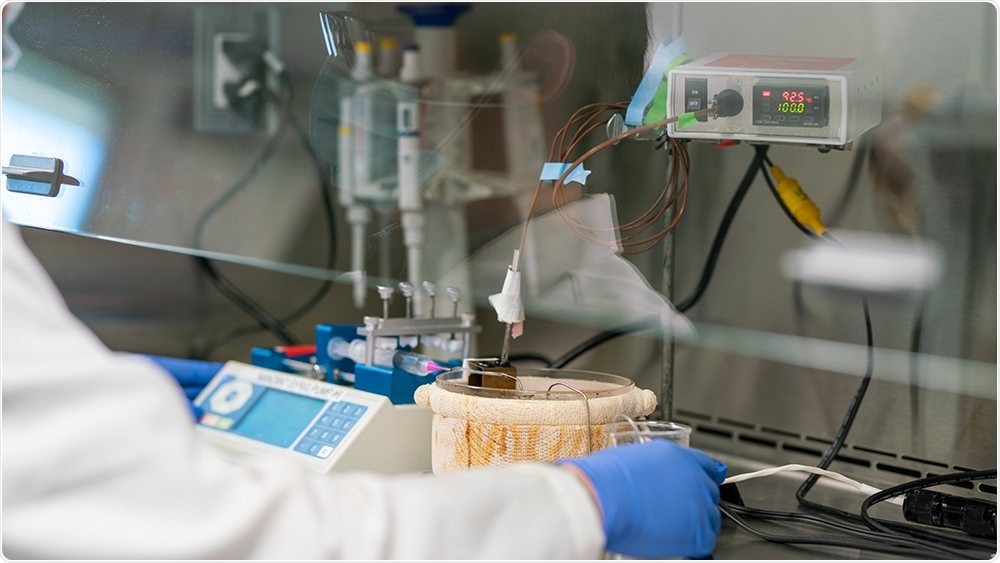Researchers in the United States have shown that severe acute respiratory syndrome coronavirus 2 (SARS-CoV-2) – the agent that causes coronavirus disease 2019 (COVID-19) – can be made incapable of infecting a host by exposing it to a very high temperature for less than a second.

If the coronavirus-containing solution is heated to around 72 degrees Celsius for about half a second, it can reduce the titer, or quantity of the virus in the solution, by 100,000 times. Image Credit: Matthew Linguist/Texas A&M Engineering
When investigating the heat treatment of mouse hepatitis virus (MHV) – a widely used coronavirus model – the researchers found that exposure to a temperature of almost 72°C for just half a second reduced the viral titer by more than 100,000 times.
Applying a temperature of just over 83°C for one second reduced the viral titer by more than a million times and completely inactivated the virus.
“This is the first systematic study on how very short heat treatment time at various temperatures influences viral infectivity, through which we have identified for the first time the minimum temperature and exposure time required to inactive the infectivity of a coronavirus,” says Yuqian Jiang and colleagues.
“This study provides essential data for the development of sub‐second CoV [coronavirus] heat inactivation approaches, including methods to efficiently inactivate airborne CoVs indoors,” adds the team.
Currently used sterilization methods
The main routes of SARS-CoV-2 transmission include contact with contaminated surfaces, person-to-person transmission via coughed or sneezed droplets, and airborne transmission via aerosol particles.
Environmental sterilization and inactivation of the virus are critical to preventing and controlling the spread of the virus.
Currently used methods include the use of chemical treatments, exposure to UV irradiation, and heat treatments.
“Heat treatment denatures viral proteins that comprise the virion, making the virus incapable of infecting a host,” writes Jiang and colleagues.
Compared with other methods, significant advantages of heat treatment include the relatively shorter treatment time required, the simplicity and safety of the method, and the potential for incorporation into existing systems such as heating, ventilation, and air conditioning (HVAC) systems.
Sub-second Heat Treatment of Coronavirus
Shorter heat treatment times are needed
Studies have previously shown that a temperature of 56°C or higher applied for minutes can completely inactivate SARS‐CoV-1 and the Middle East respiratory syndrome‐CoV (MERS-CoV).
“However, for heat treatment to be utilized for liquid and airborne CoV inactivation in broad ranges of practical settings, such methods need to be applicable at a significantly shorter heat treatment time (even if the temperature itself has to be much higher),” says Jiang and the team.
Conventional testing methods for the heat treatment of CoVs mostly involve dipping a CoV‐containing tube into a temperature‐controlled water bath.
“Such methods are valid when heat treatment time in the range of minutes is tested but cannot be used for seconds or sub‐second testing,” write the researchers.
What did the researchers do?
Jiang and colleagues developed a simple fluidics system composed of a stainless‐steel capillary tube immersed in a temperature‐controlled oil bath and then an ice bath.
The flow of virus in solution through this heating and cooling system at various speeds enables highly accurate exposure to the desired temperatures for the desired duration.
The team assessed exposure of the MHV strain A59 (5× 107 PFU [plaque forming unit] per mL) to oil bath temperatures ranging from 55 to 170°C.
What did the study find?
The researchers found that exposure to a temperature of 71.8°C for just 0.51 seconds was sufficient to achieve a more than 5 Log10 reduction in viral titer.
In addition, applying a temperature of 83.4°C for 1.03 seconds reduced the titer by more than 6 Log10 and completely inactivated the virus.
“We developed an experimental system and protocol that can conduct sub‐second thermal treatment of coronaviruses and identified the thermal treatment conditions that result in efficient thermal inactivation of coronaviruses,” writes Jiang and colleagues.
Applying the system in real-world settings
The team says potential applications of the findings include the inactivation of airborne viruses in ventilation systems and the disinfection of sewer systems.
“If a filter in an HVAC system can be heated to a high temperature, SARS‐CoV‐2 in the circulating air can be efficiently killed rapidly,” says Jiang and the team.
The researchers also say that since all CoVs are contained in a lipid envelope that expresses similar proteins, they expect that the results obtained using MHV would be broadly applicable to CoVs in general, including SARS‐CoV-1, SARS‐CoV‐2, and MERS‐CoV.
Furthermore, given that many viruses other than coronaviruses (including dengue, influenza, and measles) also express envelope proteins, this heat treatment method could have broad utility in disinfecting many other viruses of global consequence.
“Since heat treatment is a simple, inexpensive, and efficient approach to inactivate CoVs, our method can be used to further study the thermal sensitivity of viruses, as well as providing critical data that can be used to develop efficient CoV heat inactivation methods that can be broadly applied to real‐world settings,” concludes the team.
Source:
Journal reference:
- Jiang Y, et al. Sub‐second heat inactivation of coronavirus using a betacoronavirus model. Biotechnology and Bioengineering, 2021. Doi: https://doi.org/10.1002/bit.27720